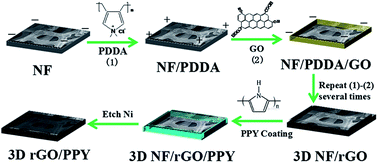Abstract:The development of tissue engineering (TE) provides a promising alternative strategy for bone healing and regeneration. For the successful application of TE, a scaffold with a three-dimensional (3D) hierarchical structure is required to provide sites for cell adhesion and proliferation. In the present study, by using nickel foam (NF) as a template, we reported a simple but low-cost strategy to fabricate 3D reduced-graphene oxide (rGO) and 3D rGO/polypyrrole (3D rGO/PPY) struts through an electrostatic layer-by-layer assembly strategy followed by an electrochemical deposition process. The results indicated that both 3D rGO and rGO/PPY could replicate the morphology of NF, while the 3D rGO/PPY exhibits better mechanical property and can be processed into the desired configuration. After mineralization, the 3D rGO/PPY/HA scaffold can keep MC3T3-E1 cells at an active proliferation state with 6.6 times upregulation at the 4th day, superior to that of the 3D rGO/PPY scaffold (5.27 times) and control group. The excellent osteoblastic performance of the 3D rGO/PPY/HA scaffold can be attributed to the good biocompatibility of HA, and the unique 3D macro-/nano-hierarchical binary structure with high specific surface area and large surface roughness. Our finding suggests that the mineralized 3D rGO/PPY can be considered as an attractive scaffold for bone healing and regeneration in the future.

KeyWords Plus:CHEMICAL-VAPOR-DEPOSITION; MESENCHYMAL STEM-CELLS; OSTEOGENIC DIFFERENTIATION; MECHANICAL PERFORMANCE; COLLAGEN SCAFFOLDS; POROUS SCAFFOLDS; AUTOGENOUS BONE; GROWTH-FACTOR; OXIDE; REGENERATION
Published in RSC ADVANCES, 6 (95):92804-92812; 10.1039/c6ra15267h 2016


